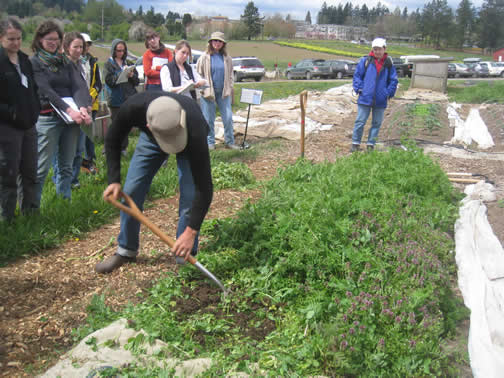Before i get too far behind i realize i need to start blogging about my Adventures in Gardening! This Spring I have started the Organic Gardening Certification. This is the Organic Certificate that falls in line with the Master Gardening Program. Both are run through Oregon State University Extension programs.
My first week was rather overwhelming because it was 7 hours of new people, new information and lots of lectures about soil chemistry, proper gardening tools (this was my favorite point of the day) with Red Pig Tools and expectations for the next 11 weeks…gulp 11 weeks of saturdays learning about dirt, i mean soil.
So last saturday was week 2. We met out at Luscher Farm in West Linn and if you havent been out there yet, GO! it is so beautiful. The Luscher family ran a dairy farm for years and willed the land to the City of Lake Oswego to maintain it as an educational farm. Today it is a community garden, a beautiful park and the Oregon Tilth Farm.
We were told to dress for rain as we would be outside for most of the day. everyone showed up with rain boots, rain pants and coats. i even brought a hat, gloves and a fleece. Of course because of this, i got a sunburn! it was such a beautiful day. we heard the huge thunder storm roll by that hit portland but we missed it completely.
we started the day with garden planning. We talked about crop rotation benefits and cover crops. We started our ongoing project of mapping our own spaces which we will add to each week.
Then we headed outside to talk worm beds, condos and motels. i learned a few very important things.
- always cover your food matter with bedding.
- the bedding can be coconut husks, newspaper or leaves and straw..or a combination of this stuff
- the bedding should be moist like a wrung out towel.
- mold is bad
- bringing in garden worms is bad. no gentrification.
- add a burlap cover to the top to keep in moisture if it gets hot.
- citrus and evergreen is bad but eggsshells, coffee grounds and tea are good
- fruitflies means too much food scrap so add more bedding
- fruitflies can turn your worm bed into a maggot bed…YEACH!
- keep it warm in the winter and have a lid to keep out the rain and sun
the worms should be super happy and create GORGEOUS organic matter for your garden in a fraction of the time it takes for a compost pile.
Next we talked Compost. of course the compost bins at the garden were huge and gorgeous. Compost consists of Greens, Browns, Water and Soil. Greens can quickly become Browns and lose important nutrients if they arent mixed in soon after cutting.
Greens: leaves, grass clippings, sod but NO SEED OR WEEDS
Browns: Straw, twigs, dead leaves, coffee chaf
Nitrogen: coffee grounds and tea
place your compost in the sunshine to get hotter! a hot compost is much better then a slow cold compost. if you can get your compost up to 140 degrees it will also kill weeds…but it has to be turned and maintained for 15 days. if you are lazy, like me, put your weeds in a seperate pile.
Manure also needs to be composted in a seperate pile. to get the most out of your chicken, goat, cow poo, place it in a seperate pile with straw covering. and ammend your soil with the poo compost after a year so it isnt too hot.
Are you spinning yet? well we are just getting started so buckle up!
After a short lunch, we talked Cover Crops! this is fascinating to me and SO GOOD for your soil. there are winter, spring, summer and fall cover crops. the roots create these beautiful pearly pink balls that will assist your plants into collecting all the nutrients they need to grow big and beautiful

simply plant your cover crop and let it go.

when you are ready to plant, cut the tops off and

then take a fork and turn the soil to get the roots and such on the underside. You can also cover them with burlap bags at this point and within a week it will look like perfect soil.
there are so many kinds of cover crops that do different things. i am sold on the legumes. they are easier to incorporate and you can eat the pea shoots!
Sedan grass and Japanese Millet lay down nad mulch in well, there is a good bug blend that brings in all sorts of lovely buggies for your soil, Phacelia is a bee lover and buckwheat is fast and collects phosphorous which is great for squash and tomatoes.
All of this comes back to garden planning and crop rotation. For example if you have 5 beds, you can put a cover crop in the summer in 2 beds then in the fall you can plant those 2 beds while adding a cover crop in the fall to a couple different beds. rotate your cover crop types and placement to keep your soil rich and unabused.
Finally we met with the lovely and talented Naomi of Naomi’s organic farm supply.
she talked ammendments and filled our heads with magical potions to keep our soil happy and balanced. the big boys are N, P, K, Ca, Mg and S.
our soil in the NW tends to be low PH because of all the rain which is great for moss and rhodies but not so great for veggies. We can easily ammend this by adding Lyme.
as far as other ammending needs, there are so many options and each is personal to your own soil needs.




